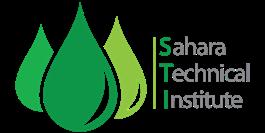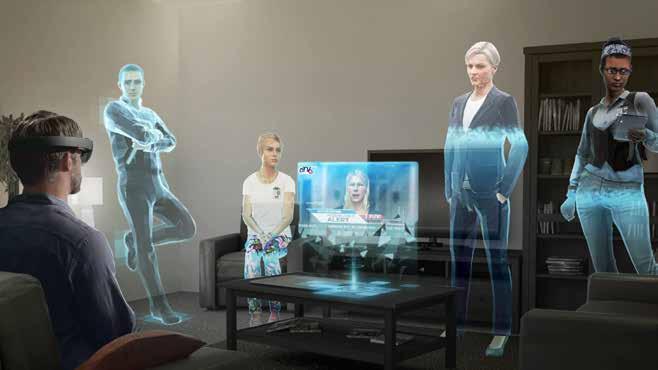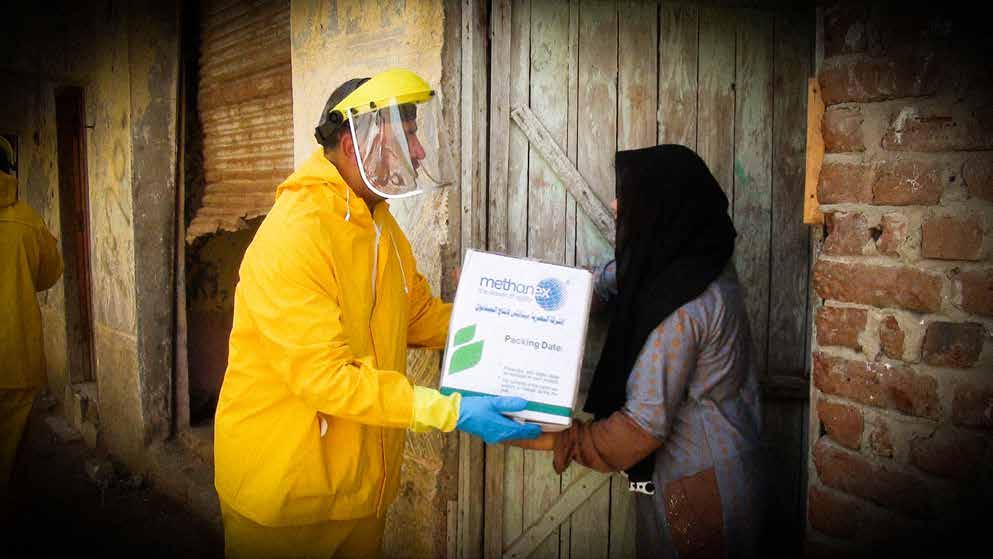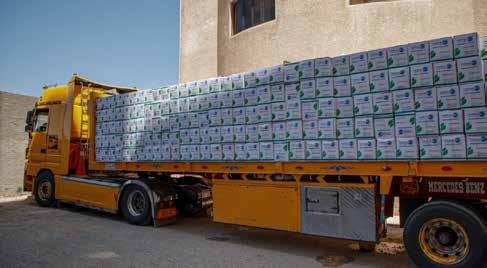
15 minute read
ARTIFICIAL INTELLIGENCE: APPLICATION IN THE OIL AND GAS SECTOR
BY JACK BECKFORD I n an industry where profit margins are becoming ever slimmer, innovation and technology is becoming in the heart of the oil and gas industry’s attempt to boost efficiency and buoy profits. Artificial intelligence (AI) helps the oil and gas companies in optimizing their production by identifying the areas of inefficiency and providing informed decision making.
Advertisement
A paper that focuses on the techniques implemented within the oil industry is “Application of artificial intelligence techniques in the petroleum industry: a review” by Hamid Rahmanifard, a research engineer at the Canadian Energy Research Institute; and Tatyana Plaksina, Principal at Aegis PetroSolutions. The paper highlights the applications of AI in the oil and gas industry, analyzing the following AI categories: swarm intelligence, fuzzy logic and artificial neural networks. Furthermore, the paper sheds light on the improvement of AI methods in the optimization of industrial decision making and the streamlining of the industry.
SWARM INTELLIGENCE
Swarm intelligence (SI) is an innovative intelligent optimization technique that replicates social and collective behavior of swarms of ants, bees, fish schools, and insects when they are searching for food, communicating with each other, and mingling in their colonies. Main characteristics of SI models are their self-organization, decentralization, communication, and cooperation behaviors between individuals within the group. In this paper, the theory of Particle Swarm Optimization (PSO) is discussed along with its use in the petroleum industry. According to the study, PSO algorithm has several advantages including a reduced number of parameters for the input data, simplicity for implementation, high efficiency in a global optimum search, and flexibility in scaling of design search. Implementation to optimize oil recovery of a heavy oil reservoir was investigated through the convergence behavior and performance of three different PSO algorithms. The results showed that conventional PSO yielded the highest objective function. The combination of PSO and the Generalized Pattern Search (GPS) simultaneously and sequentially optimizes well placement and control problems. The results shown indicate better performance of the sequential approach in comparison to that of the simultaneous approach. The study showed that utilizing hybrid techniques has led to the improvement of technical and economic scenarios for heavy oil reservoirs’ development.
FUZZY LOGIC
Fuzzy logic (FL) is a powerful mathematical tool for modeling the uncertainty of information in the real world by generalizing any specific theory from a crisp (discrete) to a continuous (fuzzy) form. It is employed to handle the concept of partial truth, where the truth value may range between completely true and completely false. Nowadays, there are numerous applications of FL in the oil and gas industry. Using a fuzzy neural network and a backpropagation neural network evaluates factors affecting rock fracturing and measures their relationship with fracture intensity. The paper found that the use of FL method and a stochastic framework, whereby a pattern that may be analyzed statistically but may not be predicted precisely, can minimize the risks associated with data reliant techniques and facilitate the interpretation process. FL has also been used in the oil industry for stimulation candidate-well selection. To determine fuzzy variables, analysis was conducted relating to the factors affecting oil well fracturing, and then selected target wells and formations for hydraulic fracturing using a fuzzy mathematics model. The results showed that optimization with GA could prevent their neural network and neuro-fuzzy models from trapping in local minima, which is a common case for a back-propagation algorithm.
ARTIFICIAL NEURAL NETWORK (ANN)
Artificial neural networks (ANN) are computing systems inspired by the biological neural networks that make up animal brains. These systems learn to perform tasks by considering examples, generally without being programmed with task-specific rules. Within the oil and gas sector, this system has been used to determine the conditions of offshore oil and gas pipelines. A case study is used whereby an ANN model used datasets from three existing offshore oil and gas pipelines in Qatar. The authors considered different factors including diameter, material, type of the carried product, anode wastage, support condition, joint condition, free spans, and corrosion.
OPTIMIZING RESULTS
The research showed that the application of AI methods has noticeably improvedperformance in terms of prediction, estimation, and optimization of different objective functions such as oil production well placement and reservoir characterization. In general, faster convergence has been reported on operations using original PSO algorithms. Conversely, hybridization of FL and ANN methods with other optimization algorithms have been shown to be more efficient and have obtained better solutions in comparison with the conventional FL and ANN models.
Keep a safe distance

Establishing trust will be key to the adoption of digital twins. Companies will only be able to extract maximum value from a digital twin if they are assured that it will function as specified. It is vital that companies in this space use a structured, systematic approach to ensure performance matches expectations, including setting clear goals and managing working processes. That is why TechnipFMC and DNV GL are developing the oil and gas industry’s first methodology for qualifying the integrity of digital twin technology. Digital twins provide virtual representations of systems and physical assets over their lifecycles. Recognizing the potential to increase safety and efficiency, the oil and gas industry is increasingly applying this technology. As the industry prioritizes digital twins and technologies integrated within them for investment in 2020, this is set to grow, according to DNV GL’s latest industry outlook New Directions, Complex Choices. The report assesses sentiment, confidence, and priorities for 2020 in more than 1,000 senior oil and gas professionals. The attraction is that a digital twin can support information-based decisions across the lifecycle of assets, from the design stage through to decommissioning. The big question though is whether the information from a digital twin can be trusted. Establishing such trust will be key to adoption, as companies will only be able to extract maximum value from a digital twin if they are assured that it will function as specified. “As more digital twins enter the oil and gas sector, it is key for operators to know that their twin works as planned, and that its output is reliable,” said Julie Cranga, Vice President, Subsea Digital at TechnipFMC. TechnipFMC – a global leader in subsea, onshore/ offshore and surface projects – is partnering with DNV GL to develop the oil and gas industry’s first methodology for qualifying the integrity of digital twin technology. It is being piloted in 2020 in two subsea development projects. To ensure that the performance of digital twins matches expectations, organizations involved require a structured, systematic approach. This shall provide evidence that the twin have valid system information and accurately predict system performance. To be qualified in this approach, a twin would need to achieve these tasks within well-defined limits and a stated level of confidence, and to do so over time. “Clearly specifying what you want to achieve from a digital twin and how you will manage the change or disruption to working processes is a genuine challenge for many companies,” said Hisham El Grawany, Vice President & Area Manager North Africa, DNV GL Oil & Gas. “Bringing clarity and structure to the qualification process is critical. In these early years of the industry using this technology, clearly specifying what you want to achieve from the digital twin and how you will manage the change or disruption to working is a genuine challenge for many companies,” El Grawany said.
OVERCOMING SPECIFICATION AND WORK PROCESS CHALLENGES
To help overcome these challenges, the industry will benefit from the twins in terms of functional elements. A functional element is the part of a twin’s capabilities that supports the user in making a specific decision. For example, the process and checklist for a functional element should cover: the need that it must meet; the key decisions it must support; and, the types, quality and number of data sources such as sensors that will be required. The feasibility of the functional element will be continuously assessed as it matures and is ultimately validated. The functional element should also cover the performance of the digital twin over time, as expressed through a quality indicator. The quality indicator reflects the fact that users need to be able to trust the digital twin at any and all times. For example, a sensor may have stopped working without anyone noticing, or the maintenance and modification work on a physical asset may not have been updated in the virtual model. “Through a structured combination of automated and audit-based assurance processes, companies can trust that the twin is always up to date,” said El Grawany. A Scalable and Broadly Accepted Methodology for All Parties A methodology to qualify digital twins should adhere to the following three principles. First, it must enable a modern agile approach to the development of digital twins, while being systematic at the same time. Second, it should be scalable as digital twins mature and evolve. Finally, the qualification process must become broadly accepted in order to serve as terms of reference between supplier and buyer, enabling efficient development and procurement processes. The methodology that TechnipFMC and DNV GL are developing aims to meet all three of these goals.
DATA AND ALGORITHM QUALITY IN DIGITAL TWINS
Advanced industrial operations depend on information systems for control and analysis. Data is increasingly considered to be of equal value to physical assets, and considerable costs are involved in collecting, storing, and acting upon data. An advanced digital twin is no exception. The quality indicator component involves continuous assessment of the quality of data and algorithms, and of the twin’s output and automated recommendations. The indicator also includes periodic assessment of the functional elements and of changes to the asset. The methodology and logic for how to ensure quality of data and algorithms is based on two recommended practices: DNVGL-RP-0497 Data quality assessment framework; and the forthcoming DNVGL-RP-0510 Framework for assurance of data-driven algorithms and models. DNVGL-RP-0497 includes a process for organizational data maturity assessment.
A RECOMMENDED PRACTICE FOR DIGITAL TWINS
DNV GL’s Technology Outlook 2030 forecasts the emergence this decade of a full digital value chain in oil and gas, with the digital twin at its core, to reduce development times and costs in the energy transition. As the TechnipFMC/DNV GL pilot project continues, the aim is to refine the methodology by the end of 2020 to publish a new DNV GL recommended practice for the quality assurance of digital twins to increase their efficiency. While the methodology is a first for the oil and gas industry, it is being built on tried and tested foundations. It is derived from the Recommended Practice DNVGLRP-A203 Technology qualification, and from other standards, adapting them on digital twins. DNVGLRP-A203 was first published more than 20 years ago as a common framework for oil and gas industry players to gain acceptance for implementing unproven hardware technology. It has been used to demonstrate the trustworthiness of hundreds of technologies. The digital twin qualification methodology being developed uses the definition of digital twins previously provided. It is applicable to alternative definitions, though this may require adjustments depending on the scope and application at hand. “We invite other companies to come forward with digital-twin modules with which we can test and refine the assurance methodology before the recommended practice is published,” said El Grawany. “We aim to create a broadly accepted recommended practice that operators and technology providers can use as a key reference. Having a standardized approach will remove uncertainty and move the industry to a more efficient future powered by trustworthy digital twins.”
HISHAM EL GRAWANY
Vice President & Area Manager North Africa, DNV GL - Oil & Gas Email: hisham.el-grawany@dnvgl.com CONTACT US TO LEARN MORE:

STI WEB-BASED TRAINING ANYTIME, ANYWHERE

The ongoing spread of coronavirus (COVID-19) presents many of us, perhaps you too, with the challenge of working from home. SAHARA Technical Institute (STI) is committed to the health and safety of its clients and employees. With that in mind, STI has rescheduled its on-site programs through May to later in the year. However, to fill your training needs now, we are delighted to introduce to you the most robust virtual training system recently implemented with our training mechanisms to support the web-based training anytime, anywhere.
The online training is self-paced and customizable to suit an individual's specific learning needs. The training can be conducted at almost any time and place, provided there is a computer with high-speed internet access. This makes this form of training convenient for users who want their training to fit into their day-to-day schedule.
The virtual training systems comply with the recent instructions of the Egyptian General Petroleum Corporation (EGPC) and the Egyptian Ministry of Health and Population to maintain social distance, in addition to the directives of the government to keep the production cycle running to maintain the country’s progress and production.

The system includes all of training lectures, assessments, knowledge progress track-records, certification, attendance, interactivity in two ways between instructors and participants, etc. Every offering has a kick-off meeting with the mentor to introduce participants and teams, establishing a web-based communication. In most programs, there is a supplemental mentor during the last day of the sessions to summarize the course results.

METHANEX EGYPT SUPPORTS MORE THAN 12,600 FAMILIES IN DAMIETTA
The global pandemic has posed a different set of challenges for individuals and corporates. Methanex Egypt rose to these challenges, truly honoring its corporate values and commitment to support the community through these difficult times. By partnering with the Egyptian Food Bank, Methanex Egypt provided food boxes to 10,000 families in Damietta where its Methanol production plant operates.
The focus of the campaign is the provision of support to day workers– those who depend on their daily wages to survive one day at a time, in addition to those who have been significantly impacted by the current curfew and the call for social distancing. The company has also set up an Employee Matching Fund, whereby the company provides full employee contributions to the Egyptian Food Bank campaign. The successful employee donation campaign has enabled Methanex to support more than 2,600 additional families to the 10,000 originally supported by Methanex’s main donation. Of these contributions, 1,000 boxes were distributed directly by Methanex Egypt’s team, in collaboration with the National Council for Women, to reach the neediest members of the community in Kafr el Battikh and Sinanya areas.


With safety being the company’s number one priority, Methanex Egypt was one of the first companies to respond to the rising number of confirmed cases and started working on response plans, guidelines and internal communications materials since January, while closely monitoring the evolving situation worldwide. After COVID 19 was announced as a pandemic and as the number of infections significantly rose globally, Methanex Egypt immediately activated its response plan and shifted to minimum manning and remote working starting from March 15 to ensure maximum the safety of its team while maintaining its full operations to meet the market’s needs. The company has also initiated a number of internal controls such as measuring body temperature for everyone entering or leaving its Damietta plant or Cairo office, having rigorous hygiene measures including daily disinfection and sanitization of common stations after each shift as well as offices and company vehicles, and requiring everyone to enter the plant or office wearing a mask.
Given the priority Methanex gives to product stewardship, disposable personal protective equipment and masks are used throughout the whole shipping process with all agreements done on radio communications. For methanol truck loading, drivers get a daily checkup and disinfection takes place for each truck. The team maintains direct and constant communication with customers to ensure truck deliveries meet the curfew timings.

9-11 FEBRUARY 2021 | EGYPT INTERNATIONAL EXHIBITION CENTER
SUPPORTED BY SUPPORTED BY
M i n i s t r y o f P e t r o l e u m & M i n e r a l R e s o u r c e s
á ` ` ` ` « f ó © Ÿ G I h ô ` ` ` ã d G h ∫ h ô ` ` à Ñ d G I Q G R h
2021 TECHNICAL CALL FOR PAPERS NOW OPEN
17 TECHNICAL CATEGORIES
Drilling (DR)
Project Management and Execution (PM)
Biofuels, Alternative Fuels and Renewable Energy (BIO) Upstream: Exploration of Conventional Resources (CONV)
Completions (COMPL)
Operational Excellence (OpEx)
Digitalisation of Oil and Gas (DIGI) Upstream: Exploration of Unconventional Resources (UNCONV)
Gas/LNG Processing, Transportation, Operations and Technology (GAS)
Health, Safety and Environment (HSE)

People and Talent Development (PPL) Geoscience: Upstream Technology Developments (GEOT) Oil and Gas Field Development (FD)
O shore and Marine Technology and Operations (MAR)
Downstream: Refining Technology, Operations and Marketing (REF) Oil and Gas Economics, Concession Agreements and Project Finance (FIN)
Downstream: Petrochemicals Technology and Operations (PET)
SUBMIT YOUR ABSTRACTS TODAY AT WWW.EGYPS.COM/CFP
DO NOT MISS THE OPPORTUNITY TO SPEAK AT NORTH AFRICA & THE MEDITERRANEAN’S LEADING OIL AND GAS TECHNICAL CONFERENCE
2021 CALL FOR PAPERS IMPORTANT DATES
CALL FOR PAPERS OPENS 7 DAYS LEFT TO SUBMIT ABSTRACTS
2021 CALL FOR PAPERS CLOSES TECHNICAL COMMITTEE MEETING
AUTHOR NOTIFICATION EGYPS 2021 OPENS
TUESDAY 11 FEBRUARY 2020
THURSDAY 18 JUNE 2020
THURSDAY 25 JUNE 2020
WEDNESDAY 12 AUGUST 2020
WEDNESDAY 26 AUGUST 2020
SUBMISSIONS DEADLINE: THURSDAY 25 JUNE 2020
TUESDAY 9 FEBRUARY 2021
SUPPORTED BY OFFICIAL MEDIA PARTNERS ORGANISED BY





